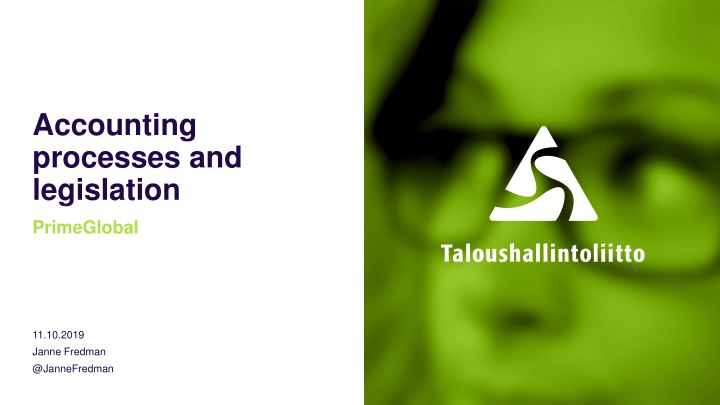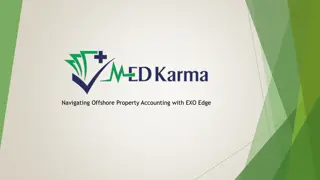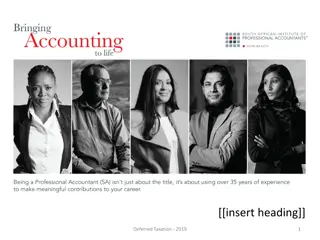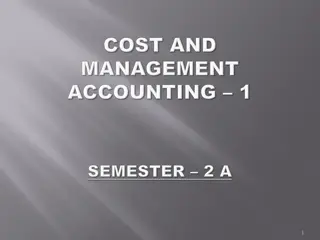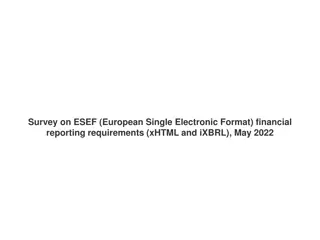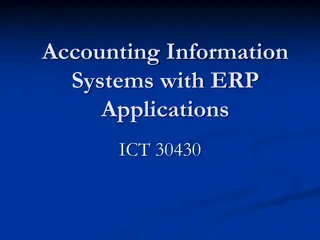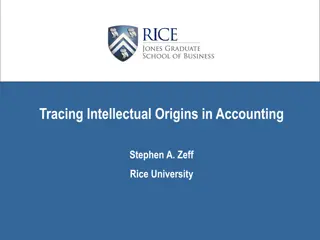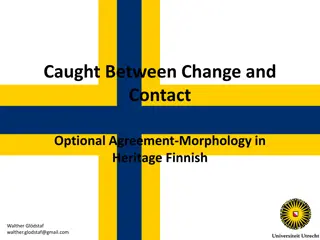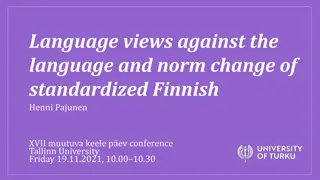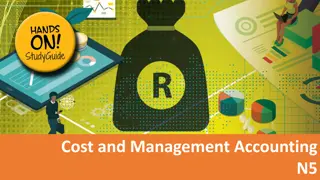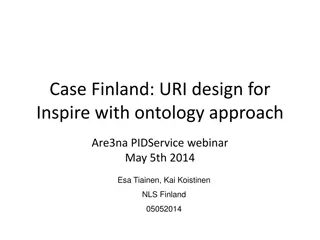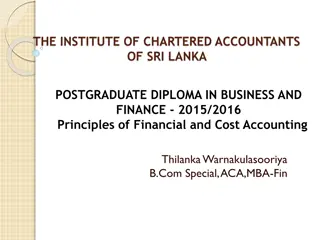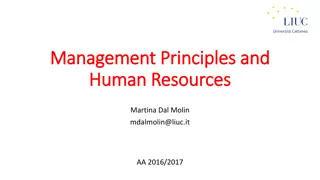Finnish Accounting Legislation and Processes: Combining Compliance and Effectiveness
The presentation delves into the Finnish accounting framework, focusing on the challenges of balancing compliance requirements with efficiency and cost-effectiveness. It also touches upon the European standard on eInvoicing and the liberalization of accounting legislation in Finland and other Nordic countries. The emphasis is on the evolution towards digitalization and the key elements of Finnish accounting process legislation and guidelines.
Download Presentation

Please find below an Image/Link to download the presentation.
The content on the website is provided AS IS for your information and personal use only. It may not be sold, licensed, or shared on other websites without obtaining consent from the author.If you encounter any issues during the download, it is possible that the publisher has removed the file from their server.
You are allowed to download the files provided on this website for personal or commercial use, subject to the condition that they are used lawfully. All files are the property of their respective owners.
The content on the website is provided AS IS for your information and personal use only. It may not be sold, licensed, or shared on other websites without obtaining consent from the author.
E N D
Presentation Transcript
Accounting processes and legislation PrimeGlobal 11.10.2019 Janne Fredman @JanneFredman
Presentation of Finnish accounting process framework multinational business calls for in depth country specific consideration How to combine compliance requirements with effectiveness and reasonable costs? What about European standard on eInvoicing?
3 My background 20 years in accounting software development (Tieto, Visma, ValueFrame) Member of the team which created electronic invoice infrastructure in Finland (Tieto and association of service providers) Finnish customs Investigation section Finnish accounting board secretary for working groups
4 Accounting processes megatrends Liberalisation of accounting legislation Outsourcing both accounting services and IT-services (Cloud/Saas) Enhanced automation by multiple means
Finnish legislation in nutshell
Liberalisation of legislation Finland Other Nordic countries 1997 Accounting Act Digitalisation ( no paper ) permitted with small restrictions and some technical preconditions 2015 revision of Accounting Act Full digitalisation permitted Archiving abroad allowed (note GDPR) No technical preconditions Digitalisation permitted in late 1990s (statutes of Finnish 1997 accounting act were utilised) Country specific variations for example Swedish tax law still demanded in late 1990s that accounting data should be stored in Sweden
7 Elements of Finnish accounting process legislation and guidelines Adequate information of transaction is documented in voucher Voucher From transaction via voucher via accounting entry to financial statement and backwards Audit trail Material is safely archived and the content is documented Documentation and archiving
8 Vouchers 2:5 The recording of a transaction must be based on a dated and systematically numbered or similarly specified voucher, verifying the transaction. The connection between a transaction, voucher and the recording entry must be verifiable without difficulty. An expenditure voucher must identify the product or service received and a revenue voucher must identify the product delivered or service rendered. The date of receipt or delivery of goods or services must be identifiable based on the voucher.
9 Audit trail 2:6 The keeping of accounting records shall be arranged so that the connection between transactions, vouchers and entries through any subledgers with the general ledger and from it to the financial statements is verifiable without difficulty in both directions. The same applies to reports submitted at regular intervals to the authorities for taxation or other purposes. P&L Statement Accounting entry Voucher Transaction
10 Documentation and archiving Documentation 2:7 a A reporting entity must have a list of the ledgers constituting the basis for the financial statements and the categories of vouchers and other accounting material, indicating the connections between them and their manner of retention. Archiving 2:7 Vouchers, ledgers and other accounting material must be processed and retained so that their contents can be reviewed without difficulty and printed in a clear written format where necessary 2:9 Financial statements, ledgers, vouchers and other accounting material must be retained carefully in compliance with the requirements of section 7 so that they can be reviewed in Finland by an authority or auditor without undue delay.
Other issues to consider in accounting office
12 Legal issues If accounting material of a Finnish legal entity is archived abroad, Finnish auditors and authorities must always be granted access to all accounting material. Breach of this may (and should) lead to criminal liability. In case financial crime (tax fraud, accounting offence, offence by a debtor ) is committed in Finnish legal entity, there is a relevant risk that accountant is also considered a suspect. Hence, the accountant (and accounting office) Must always have access to all information concerning transactions and voucher. (if not immaterial) Should consider terminating the accounting engagement in case there is disagreement with the customer concerning relevant accounting issues
13 Accounting engagement Association of Finnish accounting offices has published a template agreement and general conditions for accounting engagements. Includes content like: The responsibility for the timeliness, sufficiency, correctness, completeness and pertinence for bookkeeping purposes of the information and material of the accounting period and information and material describing subsequent events supplied to the accounting firm rests with the client. The accounting firm has the right to interrupt the Services, if the client does not provide the necessary information or material in due time or does not otherwise properly contribute to the provision of the Services, client breaches the contract in some other manner or breaks the laws, orders, instructions or recommendations of the authorities significant to the provision of the Services, or the client refuses to follow the accounting firm s entry instructions in a situation that might lead to criminal or civil sanctions for the parties. This condition is applied even if it is only a question of the parties different interpretations of the content or meaning of the law, an order, a recommendation or instructions, for example different interpretations of the spreading of income and related expenses or the valuation of assets and liabilities in the accounting or in the financial statements.
14 Accounting engament Continues: Roles and responsibilities in the use of it-systems Data ownership
Roles and responsibilities - variations Accounting service provider owns the accounting software Client owns the accounting software Accounting expertise Accounting software rights and maintenance Ownership of the data Archiving Accounting service provider Accounting expertise Accounting service provider Accounting software rights and maintenance Ownership of the data Archiving Client
16 Who owns the data? Accounting service provider owns the accounting sofware Client Client owns the accounting software Vouchers (the input of accounting process) Database Client Accounting service provider Client Client Accounting reports and other reports (The output of accounting process the subject of the accounting engagement) Client
Conclusion The understanding of the content and structure of accounting data are the key requirements of Finnish accounting process legislation. Vouchers- audit trail. Law In the cloud/Saas era, it is not about technical requirements and storage techniques but how to manage contracts Contracts Documentation of accounting material and process is the key for upkeep and development of the accouinting service Documentation
Standards, automation and process development lower costs and time for customer service
Steps of accounting automation Goals, implementation, documentation IT-systems Standards (eInvoice, payments, statutory reporting ) Accounting legislation permits digitalisation compliance and liability issues are considered
Essential standards Payments: inbound, outbound, bank statement Electronic invoice and receipt Chart of accounts (profit and loss statement and statutory reports) VAT codes and VAT exemption codes XBRL GL for integrations and audit
Elements of automated accounting process Traditional accounting automation (accounting entry automatically based on customer, vendor, product etc) Self service (PSA, Travel claims etc) Integration The cornerstones of effective accounting process Software robotics (RPA) For large organisations when better options are not available Machine learning and AI A gigantic opportunity (and threat?)
22 More automation, more detailed documentation The higher level of automatation calls for detailed documentation of accounting process so that changes in legislation, business environment, company legal structure, it environment etc can be managed Software systems and integrations Automated calculations and accounting rules Master data management RPA processess etc The profound expertise in accounting, taxation, payroll etc is emphasized in turbulent times when the accounting process and it systems must be set up to reflect the changed business and legislative environment
Different roles and profiles in accounting services Controller/consultant ? Tax/accounting specialist Process and systems specialist profile
A few words about European standard on eInvoicing
25 European standard Standard EN16931 is a description of the content and business rules not a file format or description Mandatory information Structure of the data and calculations Reference to various code lists (mainly UN/EDIFACT) The requirements of the standard can be met with UBL and CII but also with national standards (in Finland TEAPPS and Finvoice)
26 European standard business terms (BT) Id Cardin ality Business Term Description Usage Note Semantic data type The payment due date reflects the due date of the net payment. For partial payments it states the first net due date. The corresponding description of more complex payment terms can be stated in BT-20 Payment terms. BT-9 0..1 Payment due date The date when the payment is due. Date BT-13 0..1 Purchase order reference An identifier of a referenced purchase order, issued by the Buyer. Document reference
27 European standard business terms (BT) Id Car dina lity Business Term Usage Note Sem antic data type BT- 151 1..1 Invoiced item VAT category code Code The following entries of UNTDID 5305 [6] are used Standard rate (Liable for VAT in a standard way) - Zero rated goods (Liable for VAT with a percentage rate of zero) - Exempt from tax (VAT/IGIC/IPSI) - VAT Reverse Charge (Reverse charge VAT/IGIC/IPSI rules apply) - VAT exempt for intra community supply of goods (VAT/IGIC/IPSI not levied due to Intra-community supply rules) - Free export item, tax not charged (VAT/IGIC/IPSI not levied due to export outside of the EU) - Services outside scope of tax (Sale is not subject to VAT/IGIC/IPSI) jne
28 Code list - VAT Category code http://www.unece.org/trade/untdid/d16a/tred/tred5305.htm, esimerkiksi AE VAT Reverse Charge Code specifying that the standard VAT rate is levied from the invoicee. E Exempt from tax Code specifying that taxes are not applicable. G Free export item, tax not charged Code specifying that the item is free export and taxes are not charged.. O Services outside scope of tax Code specifying that taxes are not applicable to the services. S Standard rate Code specifying the standard rate. Z Zero rated goods Code specifying that the goods are at a zero rate.
29 European standard business terms (BT) Id Card inalit y Business Term Description Usage Note Semant ic data type BT-130 1..1 Invoiced quantity unit of measure code The unit of measure that applies to the invoiced quantity. The unit of measure shall be chosen from the lists in UN/ECE Recommendation N . 20 Codes for Units of Measure Used in International Trade [7] and UN/ECE Recommendation N 21 Codes for Passengers, Types of Cargo, Packages and Packaging Materials (with Complementary Codes for Package Names) [19] applying the method described in UN/ECE Rec N 2Intro 2.a). Code
30 Code list - Invoiced quantity unit of measure code YK-suositus Koodi Selite rec20 LTR litre rec20 LUM lumen rec20 XPP, EA Piece, Each rec21 X8A Pallet, wooden rec21 XME Container, metal
31 European standard business rules (BR) ID Description Business Term BR-CO-13 Invoice total amount without VAT (BT-109) = Invoice line net amount (BT-131) - Sum of allowances on document level (BT-107) + Sum of charges on document level (BT-108). BT-109 BR-CO-17 VAT category tax amount (BT-117) = VAT category taxable amount (BT-116) x (VAT category rate (BT-119) / 100), rounded to two decimals. Invoice total amount with VAT (BT-112) = Invoice total amount without VAT (BT-109) + Invoice total VAT amount (BT-110). BT-117 BR-CO-15 BT-112
32 The future of electronic invoicing Gradual shift from national standards towards international standards (UBL in Europe) More structured approach compared with the early days (code lists and minimum content) What started (at least in Finland) as an easy-access alternative to EDIFACT is slowly evolving towards explicit content definitions of EDIFACT Standardization makes the work of accountant and auditor easier
Thanks for the patience Janne.fredman@Taloushallintoliitto.fi @JanneFredman
